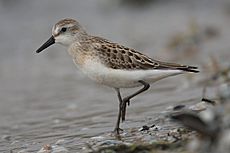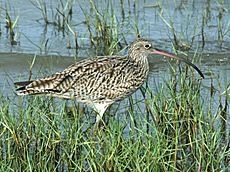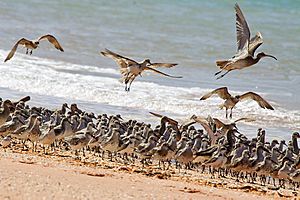Wader facts for kids

A wader is a common name for birds that walk in shallow water. You might also hear them called shorebirds. These birds are part of a larger group called Charadriiformes. This group also includes seabirds that live in the ocean and have webbed feet. The family tree of these birds is quite complex!
Where Do Waders Live?
Most waders live near wetlands or on coasts. Many species from cold places like the Arctic or areas with four seasons (temperate zones) travel very far. They are called migratory birds. Birds that live in warm, tropical areas often stay in one place. Some Arctic waders, like the little stint, fly incredibly long distances. They spend their non-breeding time in the Southern Hemisphere.
What Do Waders Eat?
Most waders eat small invertebrates. They find these tiny creatures in mud or soft soil. Different wader species have different bill lengths. This allows them to feed in the same area without fighting over food. Many waders have special nerve endings at the tip of their bills. These nerves help them find prey hidden in the mud. Some larger waders, especially those living in drier places, eat bigger things. This can include insects and small reptiles.
Types of Waders
Many smaller waders found near the coast are often called "sandpipers." The smallest wader is the least sandpiper. A small adult can weigh as little as 15.5 grams. It can be just over 13 cm (5 inches) long. The largest wader is thought to be the Far Eastern curlew. It can be about 63 cm (25 inches) long and weigh 860 grams (1.9 lb). However, the beach thick-knee is the heaviest. It can weigh about 1 kg (2.2 lb).
See also
 In Spanish: Aves limícolas para niños
In Spanish: Aves limícolas para niños




